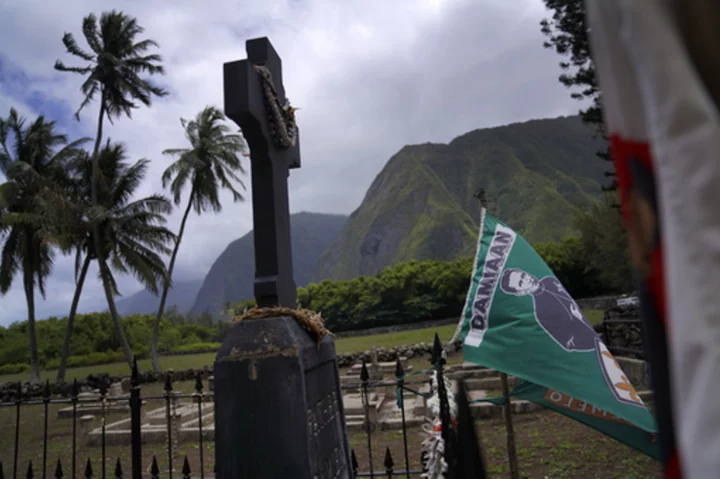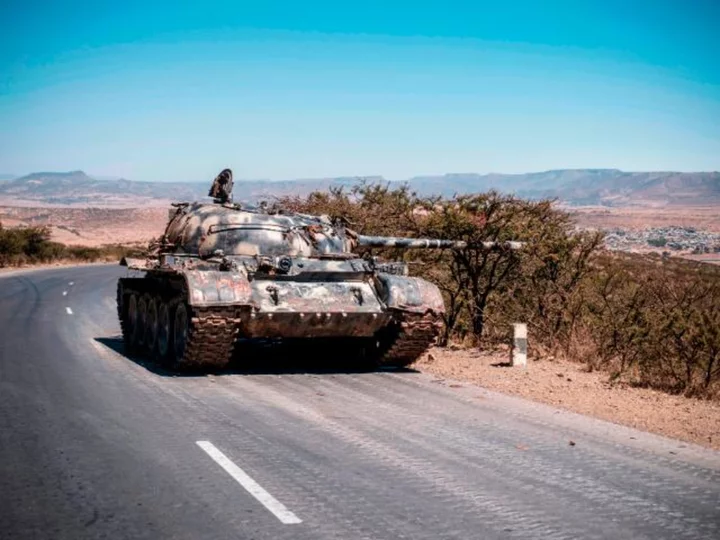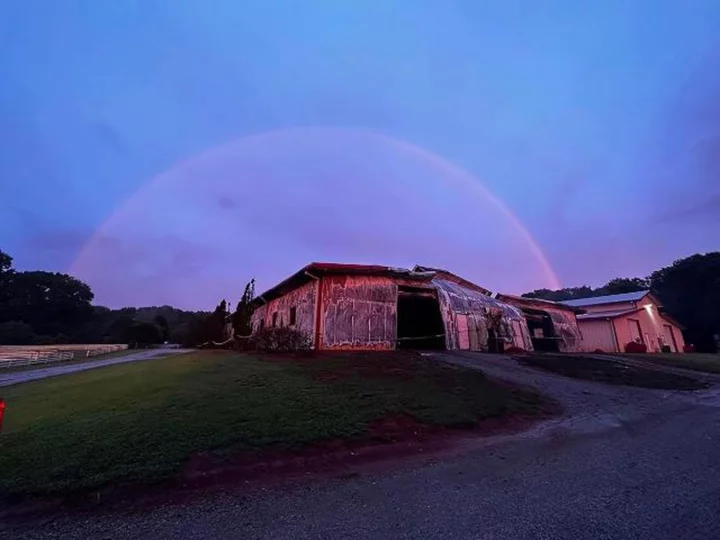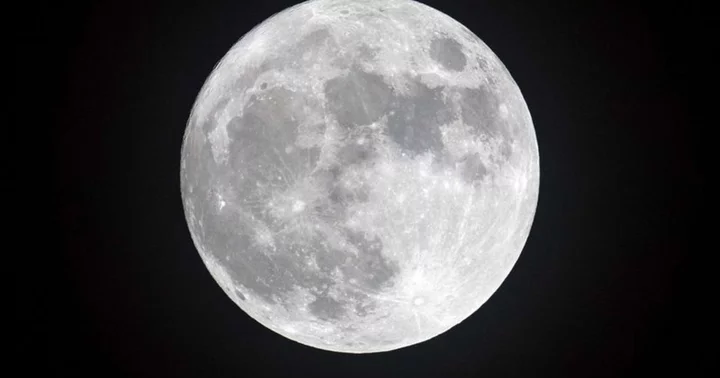KALAUPAPA, Hawaii (AP) — Kalaupapa beckoned to Kyong Son Toyofuku. She had long prayed to visit the hard-to-reach Hawaiian peninsula, trapped by its deep-green, sheer sea cliffs and rugged, black rock shores that glisten under the Pacific’s pristine waters.
As a daily Mass-going Catholic devoted to Saint Damien of Molokai, she wanted to walk where he walked, pray where he prayed, and witness for herself the place — both stunning and haunting — where the late priest spent a pivotal part of his life caring for banished people sick with leprosy.
The pilgrimage to Kalaupapa, defined by its natural isolation in northern Molokai, is logistically challenging and restricted under normal circumstances. It is even more so today because of lingering COVID-19 pandemic restrictions that canceled all pilgrimages and tours of the national historical park to protect the peninsula’s eight remaining former patients. Park and state health department officials are considering when to resume organized pilgrimages and tours.
For Toyofuku, a series of permissions came together at the right moment this summer. At the invitation of Kalaupapa’s priest, she retraced Father Damien’s footsteps in a place where for more than a century nearly no one wanted to go — and many would never leave.
Her husband, Lance Toyofuku, called all the difficulty God’s plan.
“Maybe the people who really want to get there will be able to go there,” he said. “You don’t want a million people going there every year.”
Kalaupapa, now a refuge for those who still call the peninsula home, was once the government’s answer to a deadly leprosy outbreak in the 1800s that persisted into the next century.
Missionaries, like Father Damien and Mother Marianne — who also became a Catholic saint following her service on the island — moved to Kalaupapa to care for the new residents’ physical and spiritual needs. The patients were immersed in suffering from the disease and the separation, said Alicia Damien Lau, one of two Catholic sisters currently living and serving on the peninsula, but the sick still found ways to thrive.
“The patients were all saints in a sense,” she said.
More than 8,000 people, mostly Native Hawaiians, perished at Kalaupapa, including Damien, who eventually contracted leprosy, later called Hansen’s disease. The Belgian priest, born Joseph De Veuster, is credited with drastically improving living conditions in the settlement.
“When you look at the surrounding areas, you could just feel the peace and spirit working in you,” said Lance Toyofuku, who lives in Hawaii’s capital city. “It’s not like being in Honolulu with all the cars and all the people.”
At the end of a gravel road, Damien’s grave site stands next to the church the priest expanded in 1876. The National Park Service, which cares for Kalaupapa’s cultural and historic resources, restored the church ahead of Damien’s 2009 canonization. His body was moved to Belgium in 1936. His right hand was reburied in 1995 at the site.
The group also prayed at the grave of Saint Marianne. Marianne Cope, who was born in Germany, died at Kalaupapa in 1918 of natural causes and was canonized in 2012.
Her dedication to caring for Kaluapapa’s people continues to provide comfort in the face of tragedy, like this summer’s devastating fire on the nearby island of Maui.
Soon after the blaze destroyed most of Sacred Hearts School, Principal Tonata Lolesio returned to the ashes of the Lahaina campus. She searched for a 12-inch metal statue of Marianne.
A quote from the nun served as a prominent message at the school: “Nothing is impossible. There are ways which lead to everything.”
Lolesio never found the Marianne statue, but the saint’s words help her lead the school as it continues to educate students at a temporary site.
Kalaupapa is the final resting place for so many, including Honolulu Bishop Larry Silva’s great-grandfather. Because of the disease’s stigma, Silva, like many others, didn’t learn of this piece of family history until he became an adult. When he joined pre-pandemic pilgrimages, he would point out his great-grandfather’s headstone along with Damien’s and Marianne’s graves during the settlement tours.
“The story of Kalaupapa is the story of isolation and fear,” said Silva, whose diocese includes the peninsula. But that’s not the full narrative, he said, “People were resilient and tried to make the best of it.”
A cure for Hansen’s disease was found in the mid-20th century. When the exile was lifted in 1969, some former patients chose to remain at Kalaupapa.
Kalaupapa’s quiet deepens at night, save for crashing ocean waves. The glow of axis deer eyes pierce the darkness as they dart between the settlement’s small houses — many of them vacant.
In the early mornings, Meli Watanuki’s truck is parked in front of St. Francis Church.
She chose to move to the settlement in 1969, after her husband abandoned her and took their son with him following her leprosy diagnosis. Now 88, she’s a regular at the 6 a.m. Mass along with the Catholic sisters and the occasional health department employee.
Watanuki explained that she didn’t learn about Damien and Marianne until moving to Kalaupapa.
“I love them so much,” she said through tears. “They keep me like this, make me strong.”
Bishop Silva and other church officials are eager for more people to make the pilgrimage once the diocese can resume the trips it hosted in partnership with tour companies owned by Kalaupapa residents – one of the few ways the public has been able to visit in the past.
“I have a whole list of people who said they’d like to go,” he said.
Keani Rawlins-Fernandez, the Molokai member of the Maui County Council, said many Molokai residents are nervous about tourism to Kalaupapa, which is sacred to Native Hawaiians like herself.
She worries what will become of the place when there are no more former patients living there.
On the peninsula, the walls of the house where Lau lives with Sister Barbara Jean Wajda are filled with photos of the sisters who worked on the settlement after Marianne. Lau and Wajda could be the last.
“Sister Alicia and I are committed to staying until the last patient leaves or dies,” Wajda said.
When there are no longer any patients, the state health department will also leave.
“And we both feel connected to the patients, to the land, to the saints who were here, declared and undeclared,” Wajda said. “And I think that the national park will be able to tell this story, but from a different perspective.”
___
Associated Press religion coverage receives support through the AP’s collaboration with The Conversation US, with funding from Lilly Endowment Inc. The AP is solely responsible for this content.









